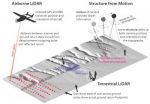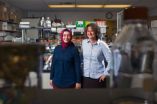(Press-News.org) To arrange for an interview with a researcher, please contact the Communications staff member identified at the end of each tip. For more information on ORNL and its research and development activities, please refer to one of our media contacts. If you have a general media-related question or comment, you can send it to news@ornl.gov.
OPTICS – Precision projectile tracker …
Rifle optical sighting systems with a 19th century heritage could blast into modern times with a laser-based bullet tracking system being developed by a team led by Slobodan Rajic of Oak Ridge National Laboratory. As envisioned, the technology would employ a sight with an eye-safe laser that tracks the bullet as it travels at speeds approaching 1,000 meters per second, rotating 4,000 times per second on its path to the target. The system would provide crucial bullet point of impact information at a range of up to one mile and could be used to correct the aim-point for a second shot. This technology is based on low-cost components and would result in much higher probability of a successful second shot. This work was funded by ORNL's internal seed money program. [Contact: Ron Walli, (865) 576-0226; wallira@ornl.gov]
MEDICAL – Needles in the eye …
Surgeons treating the millions of people who suffer from a variety of eye conditions, including recurrent corneal erosions, have a new instrument its developers believe will result in better outcomes. Plexitome is a corneal instrument that acts as thousands of microscopic needles to imprint the patient's corneal tissue, allowing the tissue to heal more quickly and completely. The instrument, being commercialized by Nanophthalmics of Memphis, was designed by a team that includes Oak Ridge National Laboratory researcher Chuck Britton and Edward Chaum, an ophthalmologist and Plough Foundation professor at the University of Tennessee Hamilton Eye Institute. The instrument allows surgeons to pierce and engage human tissue at the microscale. Unlike conventional scissors, needles and forceps, Plexitome is specifically designed for the patient's unique pathology. With it, surgeons gain greater precision and can engage tissue at the cellular scale, minimizing the risk of damaging deeper tissue. [Contact: Ron Walli, (865) 576-0226; wallira@ornl.gov]
VEHICLES – Connected to savings …
Drivers, their wallets and the environment could benefit from a connected vehicle system that could collectively save them from wasting 5.5 billion hours in traffic jams and nearly 3 billion gallons of fuel. A team led by Andreas Malikopoulos of Oak Ridge National Laboratory is developing a math-based system that exchanges information with other vehicles and drivers, local infrastructure and traffic signals while also sensing driving patterns of individual drivers. Aside from the benefits of reduced fuel consumption and emissions, connecting vehicles could save lives and reduce the need to build additional lanes and highways. A 2012 Texas A&M Transportation Institute study pegged the U.S. cost of snarled traffic and wasted fuel at $121 billion. [Contact: Ron Walli, (865) 576-0226; wallira@ornl.gov]
COMPUTING – Titan's protégé …
For students learning about multicore computers like Titan, the second-most powerful computer in the world, Tiny Titan can make the task a bit more manageable. The sub-$1,000 classroom computer can help middle and high school students explore the fundamental concepts of parallel computing, which is the key to Titan and its 299,008 cores. Working together, these cores can perform 27,000 trillion calculations per second (27 petaflops), allowing it to tackle some of today's biggest computational challenges. Tiny Titan, which has nine processors, is equipped with an Xbox controller that allows students to interact with a particle-based fluid simulation to understand how multiple computers collaborate on a scientific problem. The tabletop-sized Tiny Titan will be showcased Sept. 16 in Washington, D.C., at the Advanced Science and Engineering through High-Performance Computing National Lab Day. [Contact: Ron Walli, (865) 576-0226; wallira@ornl.gov]
INFORMATION:
Story from the Department of Energy's Oak Ridge National Laboratory, Sept. 2014
2014-09-03
ELSE PRESS RELEASES FROM THIS DATE:
Trouble starting a task? Perception of time may be the problem, study finds
2014-09-03
Completing tasks and crossing them off the ubiquitous "to-do" list is a great feeling. But what about those nagging tasks we keep putting off? What's the difference between those jobs that get completed and those that do not?
The answer may be our perception of time, according to new research by Yanping Tu, a doctoral candidate at the University of Chicago's Booth School of Business.
The study, "The Categorization of Time and Its Impact on Task Initiation," recently published in the Journal of Consumer Research, finds that people are more likely to begin a job when, ...
How much gravity is enough?
2014-09-03
TORONTO, September 3, 2014 – Keeping upright in a low-gravity environment is not easy, and NASA documents abound with examples of astronauts falling on the lunar surface. Now, a new study by an international team of researchers led by York University professors Laurence Harris and Michael Jenkin, published today in PLOS ONE, suggests that the reason for all these moon mishaps might be because its gravity isn't sufficient to provide astronauts with unambiguous information on which way is "up".
"The perception of the relative orientation of oneself and the world is important ...
Team develops new, inexpensive method for understanding earthquake topography
2014-09-03
Boulder, Colo., USA – Using high-resolution topography models not available in the past, geologists can greatly enrich their research. However, current methods of acquisition are costly and require trained personnel with high-tech, cumbersome equipment. In light of this, Kendra Johnson and colleagues have developed a new system that takes advantage of affordable, user-friendly equipment and software to produce topography data over small, sparsely vegetated sites at comparable (or better) resolution and accuracy to standard methods.
Their workflow is based on structure ...
Study sets guideline for determining effectiveness of college football training methods
2014-09-03
VIDEO:
Athletic performance varies from day to day, which can make it difficult for strength and conditioning professionals to judge whether athletes' improvements are due to effective training. Now, University of...
Click here for more information.
COLUMBIA, Mo. –Athletic performance varies from day to day, which can make it difficult for strength and conditioning professionals to judge whether athletes' improvements are due to effective training. Now, University of Missouri ...
NIH-led scientists discover HIV antibody that binds to novel target on virus
2014-09-03
WHAT:
An NIH-led team of scientists has discovered a new vulnerability in the armor of HIV that a vaccine, other preventive regimen or treatment could exploit. The site straddles two proteins, gp41 and gp120, that jut out of the virus and augments other known places where broadly neutralizing antibodies (bNAbs) bind to HIV. This newly identified site on the viral spike is where a new antibody found by the scientists in an HIV-infected person binds to the virus. Called 35O22, the antibody prevents 62 percent of known HIV strains from infecting cells in the laboratory and ...
Hawaii scientist maps, names Laniakea, our home supercluster of galaxies
2014-09-03
University of Hawaii at Manoa astronomer R. Brent Tully, who recently shared the 2014 Gruber Cosmology Prize and the 2014 Victor Ambartsumian International Prize, has led an international team of astronomers in defining the contours of the immense supercluster of galaxies containing our own Milky Way. They have named the supercluster "Laniakea," meaning "immense heaven" in Hawaiian. The paper explaining this work is the cover story of the September 4 issue of the prestigious journal Nature.
Galaxies are not distributed randomly throughout the universe. Instead, they are ...
Sequencing of 5 African fishes reveals diverse molecular mechanisms underlying evolution
2014-09-03
Cambridge, MA. Wed. September 3, 2014 — In an effort to understand the molecular basis of adaptation in vertebrates, researchers sequenced the genomes and transcriptomes of five species of African cichlid fishes. A research team led by scientists at the Broad Institute of MIT and Harvard uncovered a variety of features in the cichlid genomes that enabled the fishes to thrive in new habitats and ecological niches within the Great Lakes of East Africa. In addition to helping explain the complex genomic mechanisms that give rise to incredible diversity among cichlid fishes, ...
Airlock-like transport protein structure discovered
2014-09-03
Palo Alto, CA—Sugars are an essential source of energy for microrganisms, animals and humans. They are produced by plants, which convert energy from sunlight into chemical energy in the form of sugars through photosynthesis.
These sugars are taken up into cells, no matter whether these are bacteria, yeast, human cells or plant cells, by proteins that create sugar-specific pores in the membrane that surrounds a cell. These transport proteins are thus essential in all organisms. It is not surprising that the transporters of humans and plants are very similar since they ...
Carbon stored in the world's soils more vulnerable to climate change than expected
2014-09-03
The response of soil microbial communities to changes in temperature increases the potential for more carbon dioxide to be released from the world's soils as global temperatures rise, scientists have revealed.
The potential for global warming to stimulate decomposition rates in soils, and thus release large quantities of carbon dioxide to the atmosphere, has long been considered to be one of the potentially most important positive feedbacks to climate change. However, the results from more recent studies have suggested that responses within microbial communities could ...
Study shows cellular RNA can template DNA repair in yeast
2014-09-03
The ability to accurately repair DNA damaged by spontaneous errors, oxidation or mutagens is crucial to the survival of cells. This repair is normally accomplished by using an identical or homologous intact sequence of DNA, but scientists have now shown that RNA produced within cells of a common budding yeast can serve as a template for repairing the most devastating DNA damage – a break in both strands of a DNA helix.
Earlier research had shown that synthetic RNA oligonucleotides introduced into cells could help repair DNA breaks, but the new study is believed to be ...





